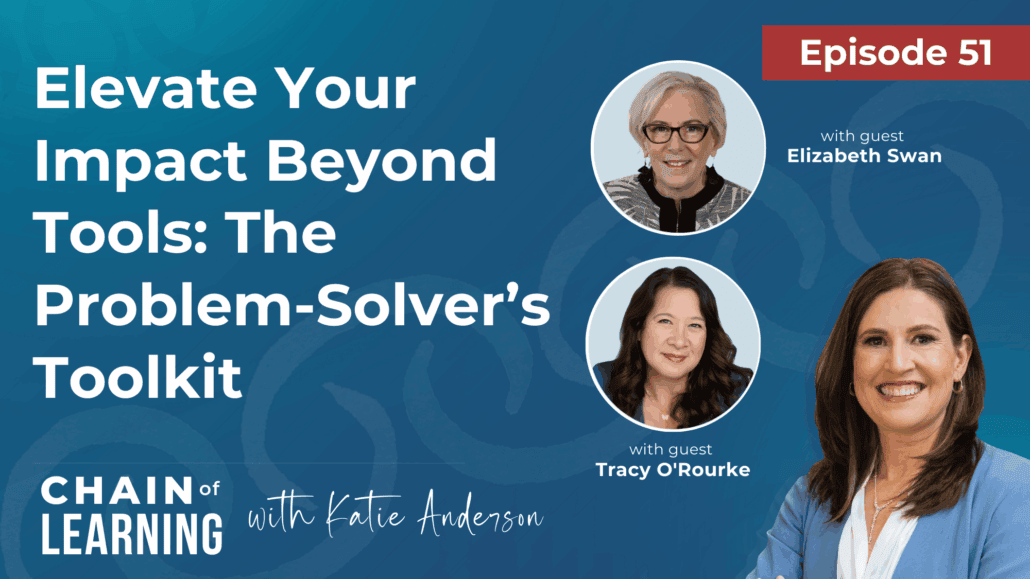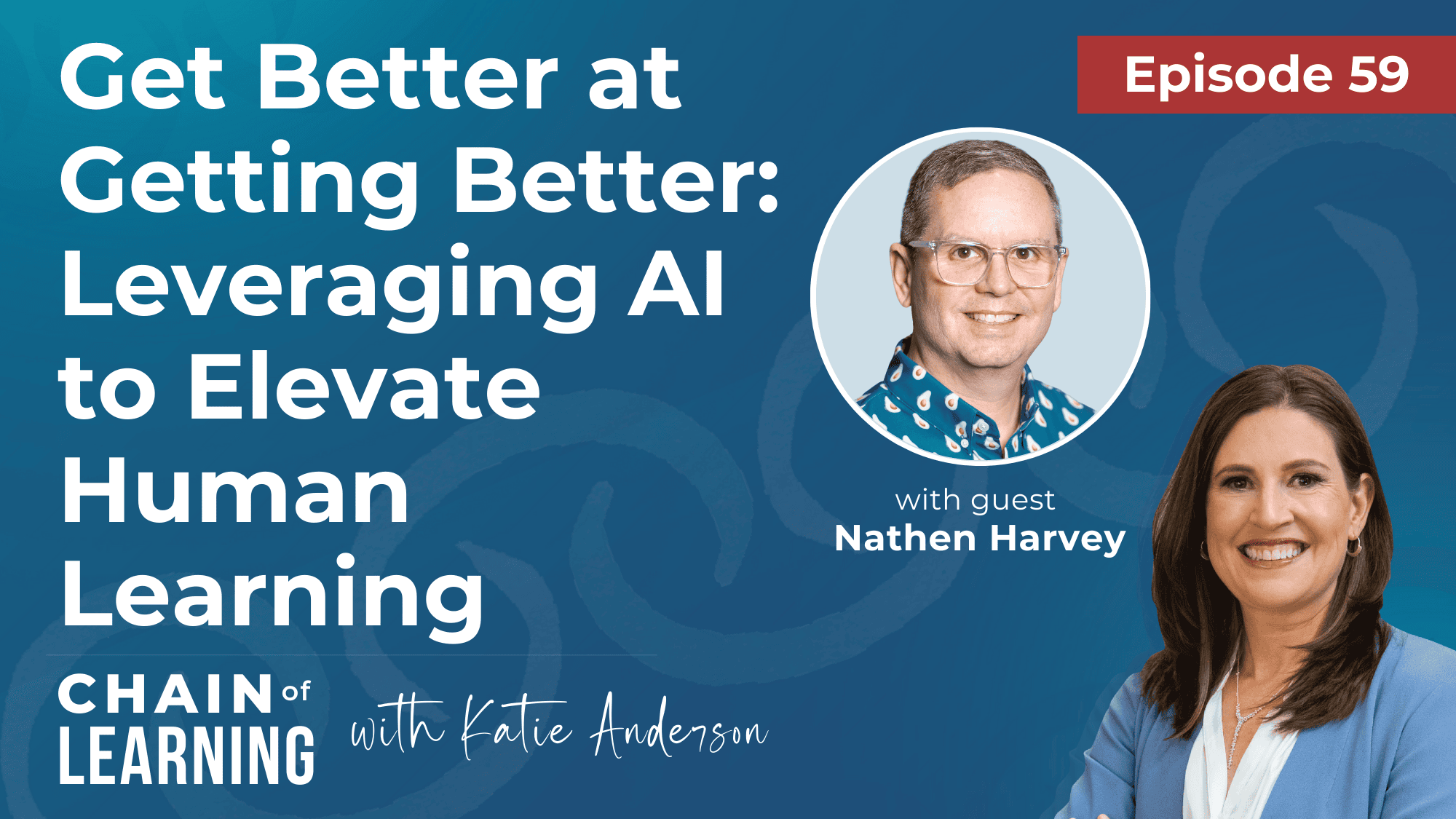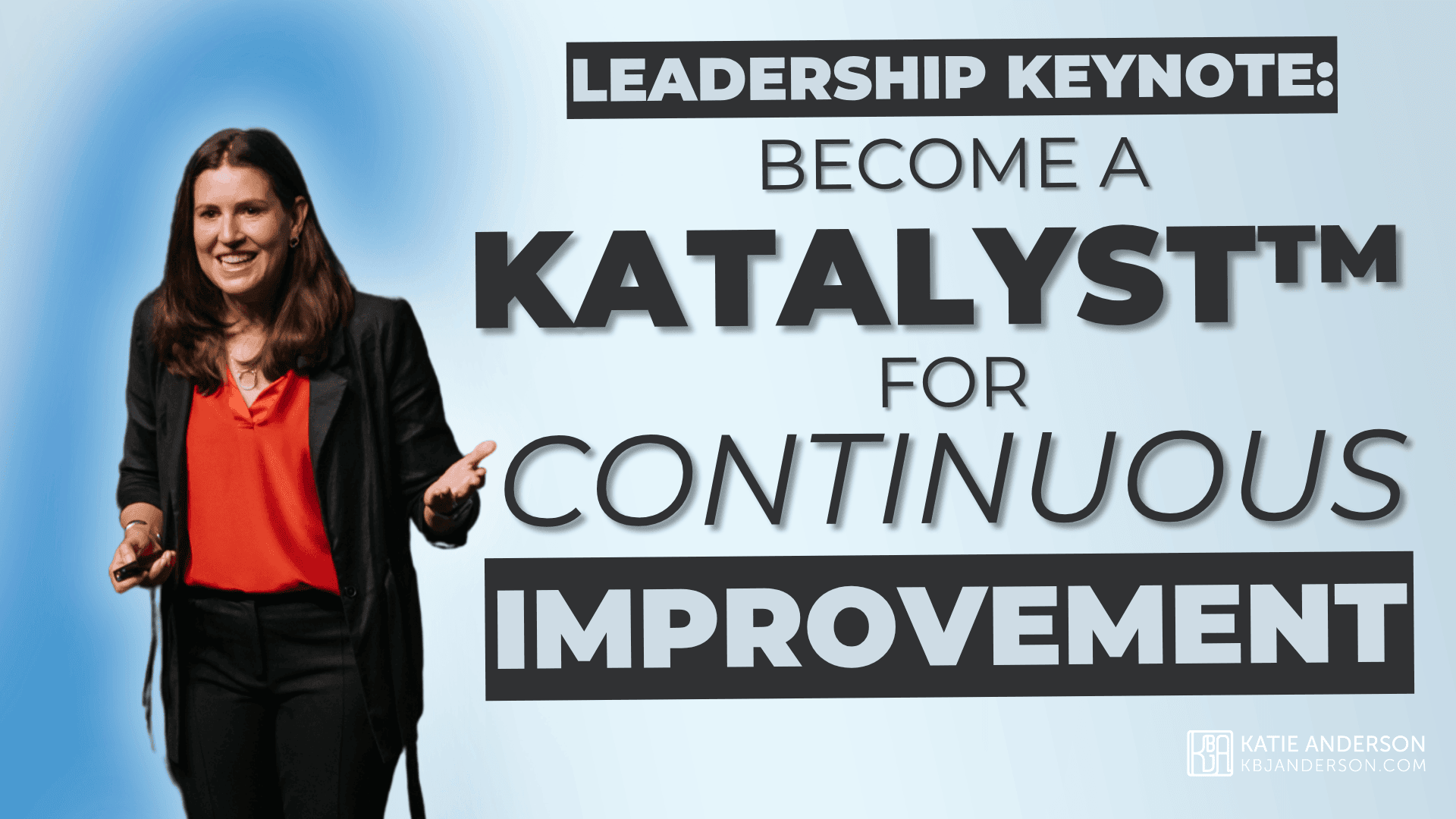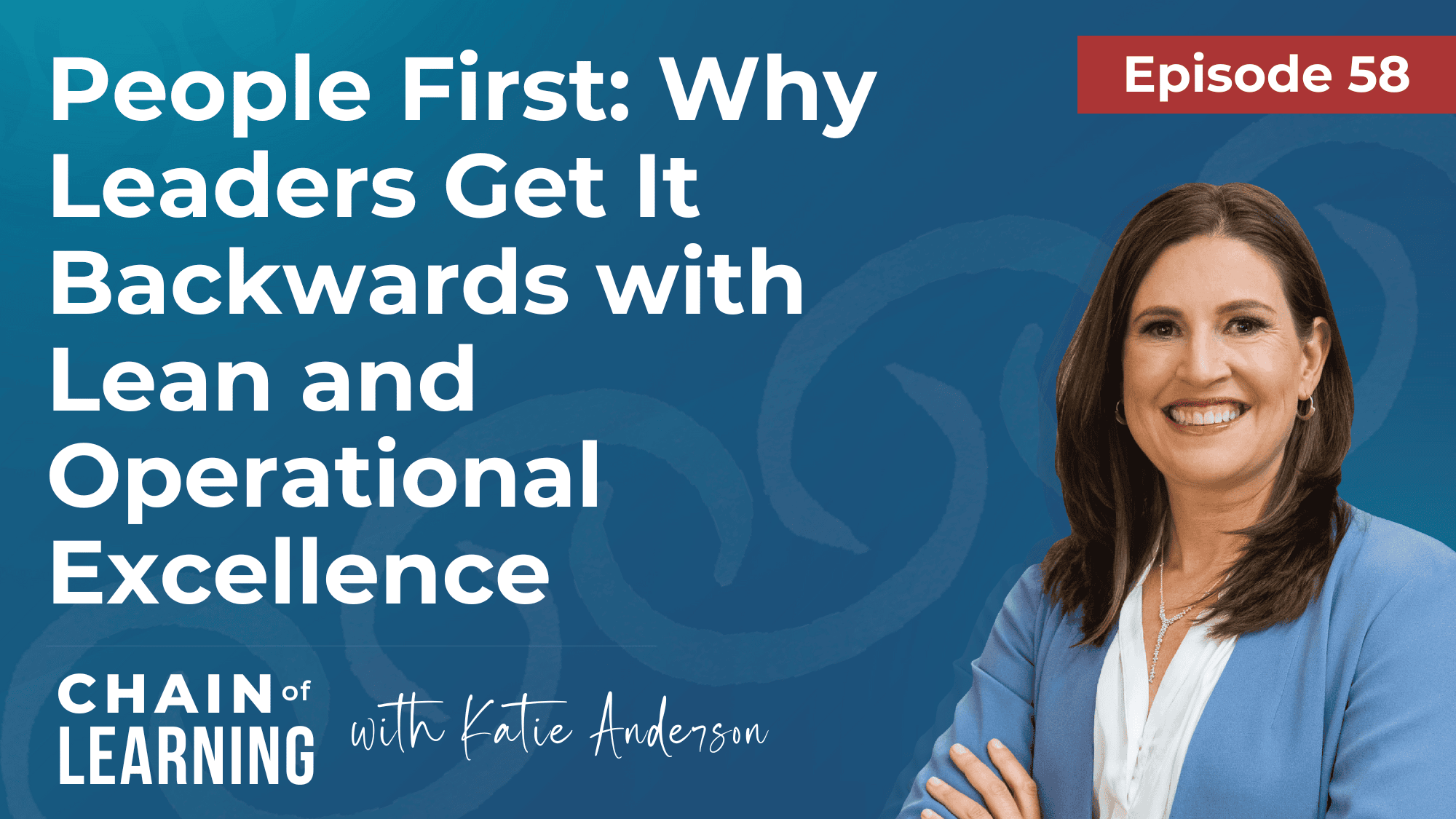Moving Beyond the Tools to True Problem-Solving
It’s a problem I’ve seen over and over again—and I bet you have too. Organizations invest thousands of dollars and countless hours into lean, Six Sigma, and other continuous improvement training programs.
Certifications get awarded. Belts get earned.
But nothing actually changes.
Technical problem-solving training alone isn’t enough to drive meaningful impact. Without guidance and support on how to apply problem-solving tools—and the people-side of leading change—improvements stall.
In this episode of Chain of Learning, I am joined by Tracy O’Rourke and Elisabeth Swan, co-founders of the Just-in-Time Café and co-authors of The Problem-Solver’s Toolkit. With more than 50 years of combined Lean Six Sigma experience, they’ve trained and coached thousands of problem-solvers across industries—from healthcare and government to manufacturing and service—helping teams turn knowledge into real results.
Whatever problem-solving method you use—whether it’s DMAIC, PDCA, or an A3—you’ll walk away with practical insights to help you bridge the gap between knowledge and action.
In this episode, you’ll learn:
✅ Why traditional training programs fail to create lasting problem-solving capability—and what to do instead
✅ The importance of bringing others along in a change project and staying flexible and curious as the work evolves
✅ Why successful and sustainable problem-solving requires both technical know-how and people skills
✅ How to engage teams, navigate change, and keep momentum going while leading a process improvement team
✅ How to close the gap between learning and doing by turning skills into real-world results
Listen Now to Chain of Learning!
Tune in to discover how you can turn your technical problem-solving skills into impact—and drive meaningful, lasting change.
Watch the Episode
Watch the full conversation between me, Tracy O’Rouke, and Elisabeth Swan on YouTube.

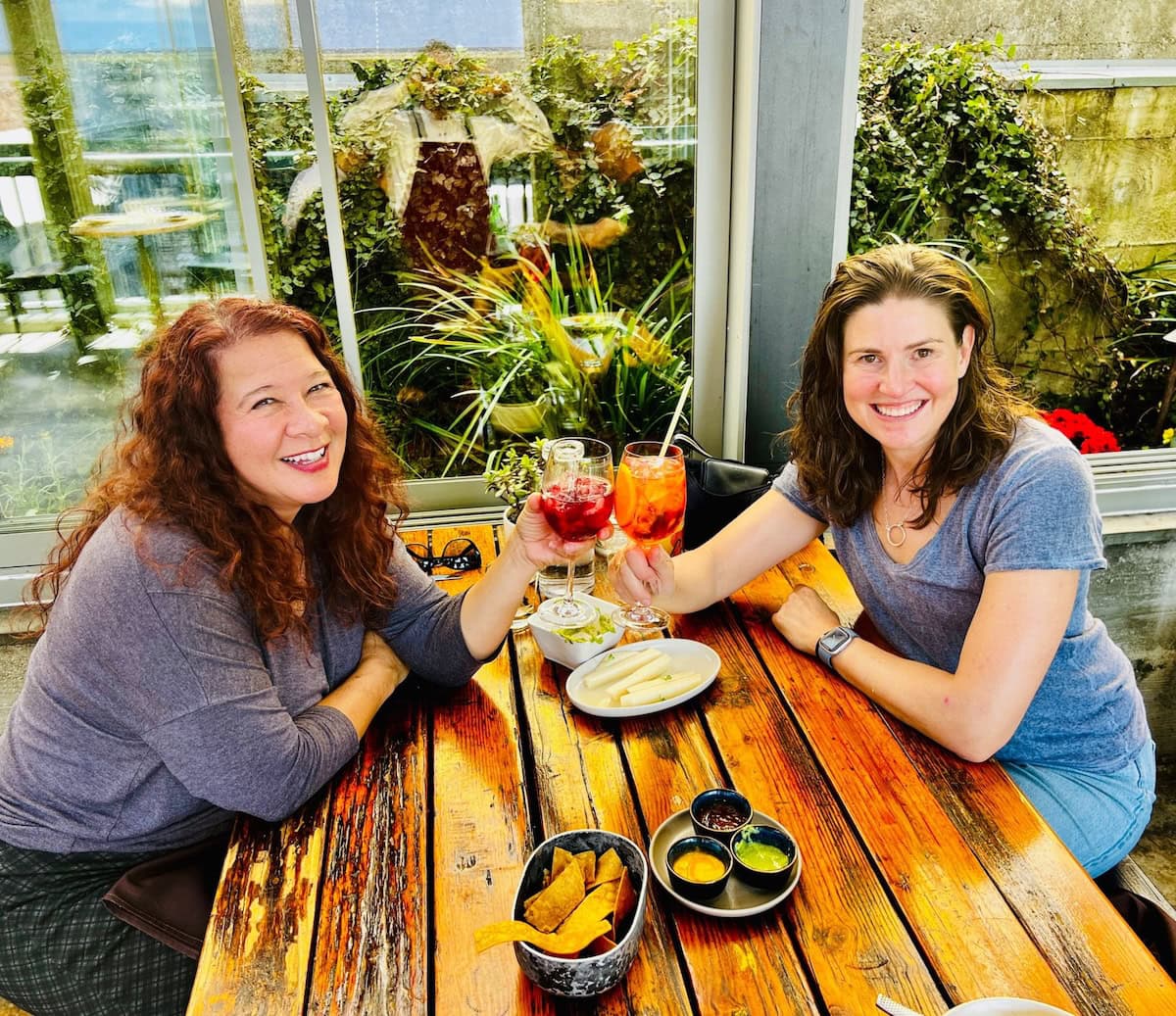
Important Links in my Chain of Learning
I’m honored to have Tracy and Elisabeth on the Chain of Learning podcast. We became friends in 2019 when Tracy and Elisabeth joined the second cohort of my Japan Leadership Experience.
Now we try to meet up whenever we can in San Diego and the San Francisco Bay Area — as well as conferences around the country.
I am so grateful that they are both an important part of my Chain of Learning. We got introduced in 2017, and then when they came to Japan with me — that immersive week together really solidified our friendship.
We have continued to collaborate over the years. I helped Elisabeth with her book Picture Yourself a Leader, she was on the editorial board for my book Learning to Lead, Leading to Learn, and I was a backup dancer in Tracy’s 5S Baby music video.

So as you can see — we’re all part of a virtuous cycle and that really is like what the Chain of Learning is about.
About Tracy O’Rourke
Tracy O’Rourke is a Lean Six Sigma Master Black Belt, co-author of The Problem-Solver’s Toolkit, and co-founder of the Just-in-Time Café. As a sought-after consultant, instructor, and speaker with over 25 years of experience, Tracy specializes in cultural change, leadership development, strategic alignment, and process improvement.
Under the alter-ego of “Ms. Fixalot”, Tracy brings humor to teaching continuous improvement concepts through her original parody music videos.
About Elisabeth Swan

Elisabeth Swan is a leadership coach, keynote speaker, award-winning author of Picture Yourself a Leader, and co-founder of the Just-in-Time Café. Elisabeth brings decades of experience helping Fortune 100 companies and nonprofits embrace conscious leadership and continuous improvement.
A former improv performer, Elisabeth believes leadership is about adapting and co-creating, not control.
Tracy and Elisabeth in Japan
Back in 2019, Tracy and Elisabeth joined me in Japan for my Japan Leadership Experience.
In this episode, they both reflect on their experience from six years ago.
Both described it as transformational—shaping their views on leadership, culture, and continuous improvement.
From learning about Ina Foods’ “100-year calendar” and its focus on worker happiness, to witnessing third graders in Japan practice respect and reflection, to spending time with Toyota leader Isao Yoshino—these experiences left a lasting impact.
As Tracy summed it up: “That was honestly one of the highlights of my career. If I could go every year, I would.”
Want to experience this transformation for yourself? Apply today!
“Honestly, going on that trip with you, Katie, was one of the highlights of my career. I’ve been doing this 25 years, and it was just incredible. If I could go every year, I would.” — Tracy O’Rourke
The Problem-Solver’s Toolkit
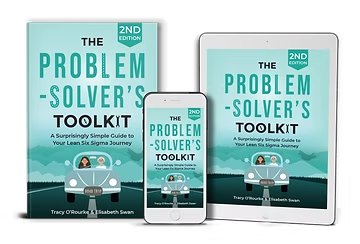 The perfect book for the process improvement traveler.
The perfect book for the process improvement traveler.
Inside you’ll find basic tool sets, examples, instructions, “detours” around potential “potholes” and some sight-seeing options when you want to learn more on a given topic.
You can get your own copy of the recently published second edition here.
Tracy and Elisabeth generously donated their book for three lucky listeners of the Chain of Learning Podcast to get a free copy of the newly released second edition of The Problem-Solver’s Toolkit: A Surprisingly Simple Guide to Your Lean Six Sigma Journey. The giveaway is now closed but if you would like to be the first to know about future giveaways, sign up for my newsletter here.
Reflect and Take Action
Learning the tools isn’t enough.
Real impact comes from using them, bringing others along, and staying flexible and curious about how the work gets done.
Successful problem-solving requires both:
- The technical know-how to identify and address root causes
- The people skills to engage teams, navigate change, and keep momentum going
It’s not about whether you’re using DMAIC, PDCA, or an A3, but the intention behind the problem-solving process, not the name of the tool.
Don’t let new skills fade when real life takes over.
- Put it into practice and reflect on what you learned
- Teach it to a colleague or team member to strengthen your own learning and extend your impact
By doing this, you’ll close the gap between learning and doing—and strengthen your chain of learning.
What’s one insight or skill from this episode you can apply this week to make your learning stick?
Important Links:
- Check out my website for resources and ways to work with me
- Connect with Tracy O’Rourke
- Connect with Elisabeth Swan
- Follow me on LinkedIn
- Download my free KATALYST™ Change Leader Self-Assessment
- Get your copy of the “Problem-Solver’s Toolkit”
- Learn more about my Japan Leadership Experience
- Check out the “5S Baby” parody music video starring Tracy O’Rourke (Ms Fixalot) and featuring Katie Anderson (MC Katalyst) 5S Baby! Teaser – Lean Six Sigma Spoof Song
- Listen to my interview with Elisabeth about her book Picture Yourself a Leader
- Tune into my appearance on the JIT Cafe podcast: Learning to Lead and Leading to Learn, featuring Katie Anderson
Listen and Subscribe Now to Chain of Learning
Listen now on your favorite podcast players such as Apple Podcasts, Spotify, and Audible. You can also listen to the audio of this episode on YouTube.
Timestamps:
01:37 – The inspiration behind the “Problem Solvers Toolkit” to close the gap between people completing a training program and not putting their new skills into practice
02:54 – The disconnect between what is education and what leads to retention
04:22 – The aha moments in creating the revised second edition in leading process improvement
05:55 – Potholes and detours as a metaphor in process improvements not going the perfect way
06:36 – The journey of continuous improvement in taking your team on the journey with you
07:26 – Incorporating road games in getting the team involved in problem solving
11:03 – What led Tracy and Elisabeth to want to help people in leading process improvement
13:31 – The real meaning of being a leader — more than just being a senior executive
16:04 – The difference between lean and Six Sigma
18:24 – Why the process steps matter more than the name
19:22 – Why people feel lean has failed
20:38 – Additional learnings in making the second edition of “The Problem-Solver’s Toolkit” even more helpful for problem solvers
21:53 – Changes made in the second edition including graphics, examples and templates
22:19 – What the Just-in-Time Café digital toolkit includes to help you on the problem solving journey
25:23 – How to solve problems based on solving similar problems
27:19 – The 5S Baby spoof music video inspired by process solving tools
29:12 – The next spoof song based on root cause analysis
33:16 – Elisabeth’s takeaways from the Japan Leadership Experience in seeing worker happiness
34:53 – The importance of focusing on human happiness and engagement for growth
36:53 – Tracy’s takeaways from the Japan Leadership Experience and seeing children learn respect and minimizing waste
40:00 – Top recommendation for being the most effective in getting traction in solving problems
41:41 – The importance of building curiosity to get to know people and their experiences
43:34 – What is involved in successful problem-solving
44:14 – How to close the gap between learning and doing
Full Episode Transcript
Tracy: [00:00:00] But you know, like this whole thing about, oh, everybody fails at lean. Okay. Everybody’s failing. All the companies are failing Lean, and I’m like, why does it have to be fail or pass?
Katie: Welcome the Chain of Learning where the links of leadership and learning unite. This is your connection for actionable strategies and practices to empower you to build a people-centered learning culture, get results, and expand your impact so that you and your team can leave a lasting legacy.
I’m your host and fellow learning enthusiast, Katie Anderson. It’s a problem I’ve seen over and over again and I bet you have too. Organizations invest thousands of dollars in countless hours, sending people to Lean Six Sigma and other continuous improvement training programs. Certifications get awarded, belts get earned, but then what?
The binders go on the shelf, the new skills fade and no meaningful problem solving actually happens. Why often because there’s no support to put those technical problem [00:01:00] solving skills into action, and no guidance for navigating the messy realities of change, the people side of improvement. To explore this challenge and how to overcome it.
I’m joined by Tracy O’Rourke and Elisabeth Swan. They’re the co-founders of the Just-In-Time Cafe and co-authors of the newly released second edition of, “The Problem-Solver’s Toolkit.” Together they bring over 50 years of Lean Six Sigma experience, having trained and coached thousands of problem solvers across industries, from healthcare to government, to manufacturing and service, helping organizations turn knowledge into real results.
We started off our conversation with this question. When you see how often people complete a training program but never put their new skills into practice, how did that reality inspire you to create, “The Problem-Solver’s Toolkit,” and how do you see it help closing the gap? Let’s dive in.
Tracy: This is a really big issue when people go through the belt level trainings.
I actually do like the belt level trainings because it, they, they are [00:02:00] specific, they can help people learn yet. There’s a lot of programs out there that you do greenbelt training and there’s no project requirement. There’s no application. We really. Wrote it because we wanted to be a companion to like a green belt.
But, but in reality it, it started to become, you know, this could be helping people app apply the, the tools and the methods if they didn’t get any type of application while they were going through training. And I’m seeing it more and more. There seems to be more certificate mills, quite frankly. And more organizations that are offering a certificate with no practical application, and it drives me nuts.
So really this was to solve the issue that I feel like I’m going nuts.
Elisabeth: I
Tracy: don’t
Elisabeth: know. What would you say, Elisabeth? Yeah, I’m with you. I feel like there’s this sometimes a disconnect between what is education and what. Leads to [00:03:00] retention and recall, and this assumption that you could just get the topics and the learning without the application and it would actually stick, and the science all says, Nope, that doesn’t happen.
And so if you’re not gonna be doing something with an educator or someone who could help you apply it, I feel like the book. Does that, you know, it let, it sort of takes the reader with them and says, Hey, here’s how we did it. You know, here’s all the ways you could do it, and then here’s all the ways you’re gonna mess it up.
And so here’s some ways you’re gonna fix it. And I think, like you said, Tracy, it’s more and more can be a way to go through with. Application
Katie: and you know, to lead process improvement. No, no matter what tool you’re using, we actually, we need to apply the problem solving tools and then also bring people along with it.
And I, I really appreciate this book as that companion that helps people do both, like both breaks down tools in a very [00:04:00] simple way about how do you go through a problem solving process and bring a team along as well. And then. I love some of the things that you added in to the book. You know, I read the first edition and I’m really pleased that my, my blurb made it on the back co of the book too.
Woo. Because I really think, you know, leading process improvement, we gotta, you know, how to use the tools and more. So tell me about some of those aha moments that you had in creating this revised second edition, uh, around that too, because that was something I really thought was a standout and makes this book.
Truly a, a great companion for anyone leading problem solving in organizations.
Elisabeth: There’s a bunch of angles we came at that Tracy and I both kind of took in from that first edition. I’d say one of them was how popular the potholes were, you know, thinking about. Usually tool books are, here’s a tool, here’s an example, step one, step two, step three, off you go.
And Tracy and I went, okay, all that. And here’s how you’re gonna mess it up. And [00:05:00] then potholes and detours. So here’s how you can fix that. And so since that was hugely popular, when we gave it to our editorial board for the second edition, we were invited them like, you got any more bottles? We’d love to hear ’em.
And they really came through and I kept thinking. There’s no more ways you could point out that this could go wrong, but there’s work environments we’re not as familiar with. Tracy and I are more service. There’s manufacturing and there were just nuances that we hadn’t considered. And so it was really fun to get those, and people were so studious, like especially Sally Toyer was like, here’s, here’s a pothole.
I’m telling you right now, this one is a killer and here’s what you do. So I was like. That was nice, right, Tracy? Yes. And I,
Katie: I want it for those, uh, listeners who haven’t read the book or seen it, it, the, one of the, the great things is it’s written as a, as a journey. Like it’s Tracy and Elisabeth in a car going on a road trip.
And so that’s where the potholes and detours as a metaphor for those, you know, those, like, [00:06:00] you’re gonna hit a hole and things are gonna go sideways, and how do we, how do you do some workarounds as well when, when things are happening? And so I, I like that metaphor because as we all know. Things are inevitably not going to go the perfect way, and we don’t often equip leaders or continuous improvement specialists or teams with like the skills to how to handle that or what to do.
And so I, I really appreciate that you brought that in to like how do you apply a tool, but also what do you do when it’s not going right or people aren’t engaging with it or you’re getting stuck. So
Tracy: yes, I mean that was very purposeful obviously is, you know, the car. The journey of continuous improvement.
All problem solvers are going on journeys. And we wanna, you know, our take is make it an adventure, right? Like, let’s, let’s, uh, how are you gonna learn buckle up, right? And enjoy the ride and, you know, what are you gonna do to, to go on this journey and make it the best journey possible? And so [00:07:00] one of the things we did add also, and I know Elisabeth will talk about some of the pieces too, is.
You know, sometimes process improvement is hard. Sometimes it’s a slog, honestly. I mean, it involves change. Change can be painful for people. Certain changes can be really painful and you know, I’d love to think it’s all rainbows and unicorns, but the reality is it’s not. We wanted to incorporate some elements to insert joy and fun.
So one of the things we created was we went through the whole book and ended up creating road games. That people could play. You know, just like, uh, any journey you go on or a road trip you go on and you’ve got road games that you play to, you know, help bonding, you know, spend the time, whatever it is, however you wanna call it.
But team building is a huge aspect of problem solving, especially on the service side, where you’ve got cross-functional teams working in all kinds of processes and, you know, what could we do to help with energizers and icebreakers [00:08:00] and team activities? I think, you know, here’s the funny thing about that too, is I used to hate those.
Really? Tracy? You’re like the big, I would think you’d love that. I know. But you know, in my younger years I always thought, oh, people are just, they just wanna get to the work. They just wanna get to the work. And I don’t wanna, you know, and I, I’m gonna be honest and say my younger self wasn’t as confident, and so I felt like, okay, they’re not gonna.
Maybe they don’t feel like I’m gonna be, um, you know, professional enough. Just, you know, what you think about when you’re young, but now, you know, really I believe in the icebreakers that energizes people go, oh, well you don’t have to do these anymore. It’s you, you could do other things. No, no, no. This is about, you know, creating a safe environment, getting to know, creating the connection.
And it doesn’t take very long. It could take 10 minutes to do an icebreaker. It doesn’t take a long time, but it does. Studies do show that that helps improve productivity of teams, especially because it reminds [00:09:00] people that we’re human. Right. So you just turned, learned about somebody’s superpower and kryptonite.
And it, you know, and you can, you can re, it can resonate with you. It can make you laugh. You, you learn something new about a coworker that you’ve worked with for 10 years and didn’t know. And so there’s, it does create that connection. And I use ’em a lot in my work, right? So when I’m, when I’m working with organizations, I’m, I’m.
You know, we’re inserting those kinds of things all the time, not just in a training environment, in a meeting environment. So we run under, add that as part of the, of the toolkit as well.
Katie: I, I think that’s, you’re highlighting something that’s really important is like, especially when we’re new or excited, like we wanna just like do the tools, like do the process improvement, but.
It’s about both the technical problem solving capabilities and the social capabilities, the influence capabilities of bringing people along. And really what you’re speaking to is what, like a component of my Katalyst model, which is being a skillful facilitator. How do we bring teams together to facilitate that problem solving process?
And I, I [00:10:00] love that you included that much more robustly in the, in this edition of, The Problem-Solver’s Toolkit.” Elisabeth, you were gonna say something as well,
Elisabeth: you know, as you. Pointed out like Tracy brings the joy, but I, I also was thinking about, you know, we wrote that first edition in 2018, so I think about we got a seven year itch and we had to come back because we’ve both learned a lot more in between.
And I love Tracy’s editions. Like the road games are largely coming from her. And some of them just cracked me up. Just asking them like, you know, how many feet or how many legs in your household? Like that is a hilarious question. So you are already starting off on this nice note, but you’re, again, people wanna talk about the dog, the turtle, the cat, the goat, whatever.
And it’s, it just brings another element and we get to know each other as humans. So I’ve also, because of Tracy, been a lot more open to, right, let’s, let’s have some fun and. Sneak in a little bit of, [00:11:00] um, psychological safety, getting to know folks.
Katie: Yes. What are, what are some of those other aha moments you’ve had in the last seven years?
I mean, you both have decades of experience leading change, leading process improvement as Lean Six Sigma consultants, but what are some of those ahas that you really wanted to help people, I guess maybe avoid as well, or at least move through more effectively through your work and through this book?
Elisabeth: The other thing we added, and this was kind of a massive aha, and this happened during.
COVID for me, which is like a lot of people suddenly were off the road and life is upside down. And I remember thinking, okay, I have a little time on my hands. What have I learned on this earth? And it got me to start thinking about the stories that happened in the, the ahas that I’ve had in my whole life.
And what have I learned and how do I treat people differently? How do I treat situations differently? How do I approach the world differently? And that turned into, uh, picture yourself a leader, [00:12:00] uh, the, the book from 2023. And so now once again, Tracy and I get this seven year Rich, it’s like, okay, we gotta get, we gotta infuse this baby with all these things we’ve learned.
So I thought, well, what, for each phase of the journey might be a really targeted chapter from picture yourself. So, and those were all about like Tracy dealing with the team aspect, the icebreakers, the, the gelling with the folks doing the work. And then I’m approaching it from, you may not think you’re a leader, you may not have a title, you may not be a manager, director, whatever.
But you’re affecting people. You’re impacting people all the time. So at these different phases, here’s some a story about this might happen to you. Here’s some ideas, or here’s some prompts to get you thinking about how else you might deal. So that’s another thing we did was add those.
Katie: I, I really appreciate that Elisabeth.
And also, uh, highly recommend your book, Picture Yourself a Leader. I was on the editorial board for that one and [00:13:00] great pictures and, and, and insights from Elisabeth. So, um, we’ll put the links to that book too in, in the show notes. But no matter for the listeners who are tuning in here, you’re all leaders at different levels.
Whether or not you are, you know, senior executive or you’re the, you know, process improvement facilitator, or you’re a manager, or you’re running a team, you’re influencing people around you. And in that way you’re leading. And I think that’s really important. And we have to then think about how are we showing up with that impact and how are we bringing people along?
That’s really what a leader is. I remember Mr. Yoshino, so you both had the opportunity to mi meet Mr. Isao Yoshino, the 40 year Toyota leader of my book when you came to Japan with me back in 2019, which we’ll talk more about later, but I remember that he, I kept calling him a leader and he’s like, I’m not, I’m not a leader.
And he was thinking leader meant the senior executive and I’m. No, no, no. You, you were a leader at Toyota. You were a manager, you were a senior manager. You led teams, you led training [00:14:00] programs like you led people. And when I reframed it for him that way, he was like, oh, okay. You can call me a leader. I get that Now.
It wasn’t related to a specific title, but it was, uh. How you’re showing up and how your impact, you’re having
Elisabeth: really nice memory of Mr. Yoshino that Tracy and I got to spend a good chunk of a week on a bus back in 2019. He’s just a. A rare human and what an incredible presence that was. That was a joy.
Katie: It was so, so good.
And he was the, the podcast episode, right? Um, before this one. So episode 50 is, is him, uh, talking about leading some change as well at Toyota. So that’s great too. Often we get, uh, in our, our community of continuous improvement, we can get hung up on is this lean, is this six Sigma? Is it DMAIC? Is it a three?
Like the actual, like title of the tool or the methodology? And I love how you. Address that head on in your book about this is a problem [00:15:00] solvers toolkit. It, it doesn’t as much matter like what we call it, it’s about the process. And I I’d love to hear your perspective on that. ’cause we’ve also had some conversations is Lean is a sigma, does it matter?
Like what is, what is that and, and. It can be alienating for some people if they think it’s like this special language out there.
Tracy: Well, yeah, I have kind of strong opinions about this and I have to be honest, you know, so I originally started in the n
at GE and it was all Six Sigma. Uh, you know, so, and then I really wanted to learn more on the lean side and I actually found my gosline and, you know, we talked, we had coffee and I told him I’d be his vana at any, any place he was gonna go, and I thought he would never call me again.
There’s a whole story in that in itself. And then he called me and I went on a couple engagements with him and I started to meet more and more lean people. And I’m gonna be honest and say they were, they poo-pooed my experience. They’re like, oh, six Sigma. Yeah, no. And I’m like, and I had a great experience at [00:16:00] GE in using DMAIC as a black belt and you know.
The thing is, is you know, ’cause people say, well lean, it focuses more on the culture and Six Sigma doesn’t, you need good culture for either, you know, like you can’t just say, oh well Six Sigma, you know, you can’t apply either if your boss doesn’t want you to talk about problems. Right. So I kind of felt a little on the defense.
Um, and I was not expecting that honestly. And, you know, I, I really kind of ran into these camps, these Lean, lean Camp and Six Sigma camp, and I’m, and I’m like, why do you gotta pick a camp? I mean, we’re all under the umbrella of continuous improvement. And if this tool works to solve the problem, use it.
Who cares where it came from? You know, why does it have to be, you have to use this or I don’t like that? You don’t use this. Why can’t it just be people learn and grow? And you know what the best tool is? Do you know what the best method is? The one that’s being used, [00:17:00] right? So you know why? If someone learned PDCA, why are you gonna force him now to use DMAIC?
Or vice versa, because it’s still the same thing. You’re still, you know, if you do it right and you’re doing it right with people, you are exploring root causes and trying to figure out what is causing the problem, and then you’re gonna. You’re gonna try to fix those root causes, and it’s the same method PDC had to make and whatever you’re comfortable with.
And I know people are gonna, you know, there’s gonna probably, I’m gonna have some haters by saying that, but you know, I, I really do feel like I kind of had to, I felt like I needed to go on the verse side because I had a great experience and, and I got into talking with someone in detail about. My experience at GE with DMAIC and, and the only way they could process it is this way, they said, well, it sounds to me like they did it the lean way.
Okay, fine. If that’s how it works for you. Great.
Katie: Yeah. [00:18:00] Tracy, how could you have any haters? That’s absurd. It is absurd. And I’ve had the same experience too. Or also like we get so excited as continuous improvement professionals, like, especially when we learn a new tool, like, I wanna apply this and I’m gonna, we’re gonna lead with the tool.
But sometimes that can be a barrier to people. So I, like I say, don’t. Don’t even tell people you’re using a certain tool, like just walk them through the problem solving process. Because even as you, you laid out like DMAIC versus PDCA, it really is the same problem solving process. We just call the steps something different.
And so if we go through like what should be happening, what’s actually happening, what’s the root cause? What are our countermeasures, what are some things we’re gonna experiment and how do we keep doing that? It doesn’t matter the format or the template or the name of the step. What matters is you’re going through a problem solving process.
Tracy: Okay. And I’ll just say one more thing. I’m sorry, I gotta get this off my chest too. But you know, like this whole thing about, oh, everybody fails at lean. Okay, everybody’s failing. All the companies are failing Lean. And [00:19:00] I’m like. Why does it have to be fail or pass? Right? Isn’t it a spectrum, uh, or journey of learning?
Like, isn’t that when we learn the best as we do something wrong and then we try to make corrections and those are the things we remember the most? Does it have to be that you failed? I mean, why can’t it be a spectrum or a continuum of learning? I don’t know. I’m gonna have haters because said that No, no.
Katie: I mean, that’s exactly what I talked about with Jim Womack a bunch of episodes ago. Is, has lean, failed? And actually we’re like, no, it’s not that it, it, it’s fail. Or not fail, but it’s like how can we learn from things that have worked and things that haven’t worked as well? It. I, I agree. Like is it perfection?
Like do we need perfection or do we have that learning mindset? Right? Like, I think maybe that’s, I wonder if that’s a barrier too, that of people, they’re like, oh, I have this belt now, or I’ve gone through this training and I need to do it all right. Like all correctly. You learn by doing. Right? And so it, and like as your potholes say, like it’s never gonna go perfectly, or the daruma dolls I have behind me, like, you’re gonna fall down seven [00:20:00] times, just keep getting up eight to ke or like fall down seven times, get up eight.
Like it’s about getting up and learning your way forward and not being so tied into my, are we doing this perfectly? Of course we wanna continuously improve, we need results. But like, don’t let that stop like your problem solving process. So like speaking of failure, you both had to learn from what was working in the first edition of the book, and you added in some ahas and you’ve also had some other things that you were thinking about, like how can you make this better and learn from either what was working well?
Maybe things that could be even better in this second edition, and especially leveraging your Just-in-Time Café and more. So I’d love to hear some of those other learnings that you had in, in thinking about how to make this book most helpful for the readers and the problem solvers.
Elisabeth: I think I can start it and then Tracy pick it up, because we both had a bunch of ahas, but one of it was, you know, bringing it into our new home.
TheJust-in-Time Café meant, hey. We are gonna redo all the [00:21:00] graphics, we’re gonna bring in all new people. We got to have Tracy’s in my hilarious little avatars in the car and throughout the journey. So that was like a kind of a joyous thing. Like, oh my God, we reimagined, uh, all the characters. ’cause now they’re in the Just-in-Time Café for the case study.
And that meant, hey, we get to redo all the infographics. Right? And that was a blast. ’cause those could be better. Like Tracy was saying, you know, it’s been seven years, so hey, let’s. Let’s step this up and let’s make it more of a story. I feel like story is a big piece of our lives, and when we actually do improvement, people don’t all behave the way you want, so hey, there’s a story at the cafe.
Not everybody behaves well the entire time. So I think that was a really nice opportunity. And then it was, oh, the, our house is the cafe, so. Let’s pull it all into the cafe. Um, so Tracy, you wanna pick it up there with what that turned into?
Tracy: So we had a lot of fun with it. We were very excited about revisiting some of these pieces and, you know, the [00:22:00] colors, we changed the colors, we changed the graphics.
And the examples like, so we have templates for everything. ’cause again, this is problem solving and there’s lots of tools and templates that you can use. So we updated the, the example for all of the templates, which was great. And we created, as Elisabeth said, a new digital house, which is the JIT Cafe.
And you can go to it, you know what goes along with the analogy of the journey. You can go to the glove box. A glove box is our digital treasure chest of, of templates that you can go to. And, you know, we’ve got some descriptions, but mostly it’s, it’s got the road games, it’s got the personal pit stops, it’s got the templates for every phase.
And so now it’s all nicely packaged. On the JIT Cafe and it’s always accessible for people. It’s free. So you get all these templates for free and all the road games are free. All the pit stops, personal pit stops, [00:23:00] you know, it’s all there. So we are super proud of that too ’cause we wanted to make sure that, you know, people didn’t have to figure it out.
Like, so we talk about all these great tools. How about having a digital toolkit to go with you on the journey?
Katie: That’s awesome. So people can go and download all of the resources that you’re, you talk about in the book.
Elisabeth: Yes. All of Tracy’s fabulous road games, the icebreakers, the team activities, all the excerpts from Picture Yourself, a Leader, those are the personal pit stops.
Tracy’s mentioning all the,Just-in-Time Café and in the glove box, uh, and. I would say back to another aha, Tracy and I had, we’ve both worked with clients with, with students, with uh, customers who struggle with the onboarding process. And that just felt like, hey, if we were gonna do example, ’cause at one point we had a medical example and we still do, there’s a healthcare example on a lot of the templates and there said, Hey, this is such a universal process that [00:24:00] you’ve either been through it.
Or you’re bringing people through it, but either way you have felt the pain of onboarding a new hire when it doesn’t go right or fast or completely. So there is a new hire example on every single. Template and we worked hard at that, Tracy,
Tracy: and some of ’em were real pains. I mean, so I teach at uc, San Diego every quarter, every cohort.
I require a project to be done as part of the Greenbelt course. And so people will bring projects every year and the public course. Is is taught every semester, and the number one process people bring to work on is onboarding. I see it at least once a semester, if not more than once. I think in one class I had three people working on onboarding.
Katie: One of my clients recently, that was the top, that was the number healthcare organization, their number one. Low hanging fruit problem. They’re like, if we can get this and get physicians in faster, we are [00:25:00] like, that’s going to solve so many problems that we have going on. So,
Elisabeth: yeah, so if that’s your issue, if that’s your problem, get the book.
’cause the answers are all, you know,
Katie: although the problem might be different, but there’s probably some great ideas in there. No, no, Katie, it’s all
Elisabeth: there. It’s
Katie: all good. One and done. Solve that problem. Done. No, but I think we’re laughing here. But that’s a really important point for problem solving too, is that we can learn a lot what’s worked well in solving similar problems, like say on, on onboarding that, but to get really specific on what is your process problem, what is the process problem that you are encountering?
’cause we tend to jump to solutions a lot, right? We’re like, especially when we love problem solving. We’ve seen it there before. I mean, uh. And so like, how can we learn and get the great ideas, but make sure that we’re, we’re not just, that we’re putting in solu like countermeasures that are actually gonna solve the problems that are going on in our organization.
So,
Tracy: I mean, every single time I saw onboarding, the process was different. The root [00:26:00] causes were different. The problem was different. And so it’s never boring. It’s never boring, and you’re kind of like, wow, that’s what it was this time. That’s interesting, uh, because it’s never really the same. That’s where you really need to apply the method and the root cause analysis and stick with it and be, be curious and investigate those because.
I think, you know, I think once you start to do that, the standard solutions that people always have, training automation, throw people at it. We need people, you know? Okay. Yeah. But that’s not really changing the process. It’s, you know, a side, A side peripheral improvement.
Katie: Or we’re throwing darts and like, but not sure.
Yeah, if like that’s, you know, maybe it’s, maybe it helps, but yeah, maybe it doesn’t. We don’t really know why or, or why not. So, and how can we also be inspired by things and learning from others so that you’re not always recreating the wheel. So define the problem and then be inspired by other. Other ideas and solutions that folks have come [00:27:00] up with.
Yes. So I was, I was laughing Tracy, when you said that you were, you know, early in your career, kind of poo-pooing the team building or whatever. ’cause I can’t think of anyone besides maybe me who’s as loves team building and bringing people together in high energy. And for those of you. Who don’t know?
Tracy has an alter ego named Miss Fix a lot, and she has produced, like written, produced two spoof music videos for the Lean community. And I had the pleasure of being, uh, a guest appearance in 5S Baby. But maybe Tracy, just talk to me about your, like your, you know, these, I will put links for this in the show notes for sure, because if you haven’t watched these, they’re incredible.
Tracy: You know, I’ll just tell the story really quickly. ’cause it’s funny ’cause a lot of people just would ask me, why did you do that? I’m like, what do you mean? So people just were, well, I don’t understand. I mean, how does a master Black belt consultant, you know, just come up with a spoof song? And a lot of it was, I got inspired.
I heard a, a [00:28:00] song called, I like big books. And it was from Baby Got Back and it was education related and it was all about school and it was great. And I thought, oh, it would be so cool if I could do something. Like Baby Got Tools and I started writing them the lyrics and I kind of forgot about it.
Actually. I wrote like half the song and then I just got busy and forgot about it. And then. I was reminded that I should probably finish it by one of our Sam Morgan. Was it Sam Morgan? He was the one that said, you need to finish that, and I, so I said, you know what? You’re right. So I finished the first one.
I wrote all the lyrics, and then I could not understand anything I was saying. So I was talking so fast, wrapping so fast in the video, couldn’t understand it. So I said, I need a music video. And I found this awesome music vid real music video producer. And he, he like made it all come to life. I was so impressed.
I was like, wow. So, and of course you were in my second one and you rocked it, Katie. I mean, like, the girl flies in for one day between a business trip and a [00:29:00] vacation and she managed to pack, uh, like many types of wardrobe outfits for the eighties theme. I was so impressed. And, um, and she rocks it. She just comes in and she kills it.
She flies out the next day. And guess what? I wrote another one.
Katie: Can you give a little preview or are you holding it for a Caesar?
Tracy: I don’t know. Should I share it? So I just literally finished the lyrics and right now I’m practicing the lyrics in, in the song format. ’cause you know you need practice. You can’t just go into the studio to record it without practicing.
So I’m in the practice mode and I’m probably gonna record it in the next two weeks. And once it’s recorded, then I, I actually reached out to my music video producer today. And, um, so I have a couple people on the list that wanna be on in the video now. And so I, I promised them that they could be in the video this time.
Should I tell ’em? Yeah,
Katie: let’s hit it. I, I wanna
Tracy: know. Okay. What’s the next one? All right, so it’s actually not an eighties rap song. I was at a [00:30:00] conference and this guy, I was at the Lean Construction Institute conference and this guy Trey, who has, who heard my videos, he goes, he like, he didn’t even say hi to me.
He just goes, I know what your next song should be. And I’m like, well, okay, what? And he’s like, you need to do this song. And he told me and I was like, yes, we are doing that song. Right. Okay. It’s a 90 song. It’s by in sync. And the song is, buy, buy. Bye. So when you hear it, they say, bye bye. Bye. Bye bye. So guess what?
That became five why’s. Why? Why, why, why,
Katie: why, why? Oh my gosh. That’s amazing. And five Why’s is one of the key tools. I am, you know, about problem solving. Are you talking about root cause analysis?
Elisabeth: I also love the collaboration on that. Like, it’s funny, I have the improv background. Tracy’s got some serious improv instinct, just like.
To build, like, okay. That sounds great. All right, let’s do that. [00:31:00] All right, now I’m gonna take it. Okay, let’s go. I love
Tracy: that. So I’m, and I love it. It is so, I mean, it’s funny, the, my favorite part is this. Oh my gosh. It’s just, it’s just funny and I can’t wait to make it a goofball. Video because that’s like my favorite thing is just being a goofball in a music video.
Katie: And I love being a goofball with you as well in your music videos. So, so thank you for that. And I think that’s really important, like problem solving and continuous improvement, all this like it can be fun and it should be fun. And that’s also how we engage teams and uplift them and not just have this be this like we’re doing this process improvement.
That’s boring, but how do you have. Meaningful change that’s engaged where people are energized and excited by what they’re doing. And so bringing that energy is awesome. Tracy, so thank you.
Tracy: Yeah. Somebody, somebody told me you, you missed your calling. You should have been a rap star, not a process improvement person.
It can be
Katie: both. Both. It’s not either or. It’s And in both. Thinking. I think this also speaks to like the power of [00:32:00] collaboration and I am so grateful that you two, both Elisabeth and Tracy are such an I in critical part of my, an important part of my Chain of Learning. I mean, we, we got introduced, you know, gosh, probably 2017 or 18, and then you came to Japan with me, and that really solidified our friendship, our relationship, like this immersive week in Japan.
And then, you know, collaborating afterwards, Elisabeth helping. Be part of your book, picture Yourself a leader and helping, uh, be a backup singer for your five s uh, vid Baby Video, Tracy and other collaboration that we’ve been, uh, we’ve had. I get to be on your editorial board for your book. I know that’s true though.
Elisabeth was on the editorial board for “Learning to Lead, Leading to Learn”. So I thank you. And, and so it’s this virtuous cycle and that really is like what the Chain of Learning is about. And I, I feel like you’re helping enable people to create that Chain of Learning too by helping solve important problems and figuring out how to engage them and, and, and build, build that learning as well.[00:33:00]
Um, I’m always curious in talking to people who come to Japan with me over my eighth cohorts happening this year. It’s incredible. You’re in cohort too, but like, obviously. It’s a fabulous experience. Like I, you know, we, we know that, but I’m really curious, like, you know, what was some of the lasting impact or takeaways that you had from that experience that’s really influenced you, uh, as a consultant, as a leader, as a human being?
Elisabeth: The big, unbelievably exciting thing for me was I had just read tree ring management. Tree ring management. Yep. By Ina Foods. Yeah. Tree ring management. Then we went to Ina Foods. And the revelation of what that, how that manifested as a company and you know, things like his a hundred year calendar, which is right behind me here.
I have my own copy. That’s such a great way to look at the world and the way everybody there. Was part of the community, and they could take the, they could work [00:34:00] on the grounds. They could take the tools and go home and work on their own grounds. And the place was beautiful, that beauty was part of it. And there were art galleries and local artists.
It just was this incredibly inviting community that was producing great things. I think about all the time when I was out there, they were producing Saran Wrap that was made from basically Agar, right? Seaweed. So it was like. I love this, like just building great things, doing great improvements, all focused on worker happiness, like just those, it was just, he turned so many things upside down in, in a great way.
Katie: Thank you. I mean, as Ina Foods is one of the cornerstone parts of my, my program, and I, I found out recently I’m the only international guest that they have. They, they, they offer up learning experiences for people to come, go see from Japan, but it’s exclusive to me, so it’s just really special. Um, and the, the focusing on human happiness and engagement in the long-term view and that growth happens, like whether or [00:35:00] not it’s big or small, year by year, and it’s about getting a little bit better every time.
You know, we get so focused on those outcomes and the problems we need to solve. But like, if we can get back to that essence, it’s, it’s so powerful. And I remember it was Elisabeth, I think it was you who might’ve asked, ’cause we were like, how do you measure happiness? Um, and that was a real aha. Like we were talking, ’cause we were talking about like how do, like they have happiness in their organization.
And the executive said, he was like confused by your question and he said, how do. I don’t understand. He is like, well, why would you measure happiness? Like, because you would know as a leader, like he’s like, do you, you know, put a survey out to your family? And you know, he is like, no, ’cause you know if they’re happy or not.
And so I think that really speaks to just a different mindset that we tend to be so measurement oriented, which is of course, really important. But we are overly measurement focused. And it’s actually, if you’re out there with your team members, you can see what’s, uh, what’s happening. So I thought it was a very provocative and important question because it really highlights again, how can we turn our [00:36:00] thinking on, on our heads too about the value of the work that we’re doing and, and how we’re showing up.
So thank you. ’cause that has been one, that was to me one of the biggest learning moments I’ve had in Japan.
Tracy: Me too. I mean, I was gonna say the same thing is I, I was like, oh, I think we have a translation issue. Why does he not understand our question? Because it’s all through a translator. And then he totally understood the question.
He just didn’t understand why we were asking it. Right. And he was just like, yeah, I mean, like that blew me away when he is like, well, do you survey your family members? No. And then I realized at that moment that it’s like a completely different shift in how they view people who work there. It is a welcoming to the family.
And just, it was a very impressive, uh, visit to Ina Foods. But I, I, so I can’t say that that was, you know, ’cause that was already taken. But I also enjoyed going to the school too and watching third [00:37:00] graders learn about respect. And I think what blew me away there was, first of all, everybody ate the same thing.
Like try to hap That happened in a third grade school here.
Katie: Even at my dinner table, right? With
Tracy: my kids. Yeah. Even at the dinner table, everybody’s eating different things every, all the kids ate the same thing. They prepped the food. They made the food, they served the food, they cleaned up the food. They didn’t have like a cafeteria that you go to.
It was the kids that were doing it. But I think the very important. Like memorable question to me was everybody got their food and just before they sat and ate, they had to reflect on one question, and that was, do you feel that you can f finish the amount of food on your plate? And if you can’t put some back now what?
Katie: Yeah,
Tracy: it’s true. They do it. The idea of waste and just minimizing waste because the expectation is. Your plate will be clean and you need to [00:38:00] decide how much you are going to be able to finish. And if you can’t finish, then put some back now. But if you want more, take more. So it’s not like, you know, so like that incredible reflection of third graders, like really thinking about, hmm, how hungry am I?
Blew me away. And that’s just so not how that works. It was just a very different cultural change that I remember vividly and I had so many good experiences. I honestly could say that that was one of the highlights of my career. Katie is going on that trip with you? Um, you know, to me, I mean I’ve been doing this 25 years.
That was just incredible. I, I, if I could go every year, I would go.
Katie: I’ve had people have come back more, come back, not just once. So maybe, maybe sometime in the future we can, uh mm-hmm. Mm-hmm. Make that happen. And I, I, I really value that. And, and to me it’s also building this community and, and the relationships that we’ve had and how we’ve been able to continue to help, um, each other and, and help other people too.
And [00:39:00] so, thank you for being a part of my Chain of Learning. Yes. There’s so much more we could talk about, but you know. At the end of the day, in this field of continuous improvement, it all comes back to solving problems, right? And then in, so we gotta know how to solve those problems, not just put our training on the shelf, but then bringing people along too.
So I, I love the book, “The Problem-Solver’s Toolkit,” and it’s a great resource for anyone who’s, who’s solving problems. And if I had had this when I was leading continuous improvement teams in organizations, so I mean, I’m much more focused on the leadership side now and the behaviors. This is. Such a incredible tool book for, you know, a guidebook, really, not just a tool book with their, you know, got the glove box, but to really help make sure that we’re going through that right process.
So thank you for helping pair the technical and the social side to help people put into practice what they’re learning, because that’s what’s the most important, right? It’s like, what are we doing with the knowledge that we’ve gained? So as we close, I have one. [00:40:00] Question for you both. What’s your top recommendation for folks coming, you know, who are excited about problem solving and maybe have taken a few training classes?
Like how can they be most effective in, in actually getting traction in solving problems in their organization?
Tracy: I think curiosity is the most important thing. Humble cur curiosity, and so really trying to understand why things are the way they are. Uh, because change, change can be very difficult and a lot of people try to avoid it, and they, but I, I just think being curious and holding onto that curiosity and, and, you know, being curious about what people do and asking people respectfully because you wanna understand.
And I think being a student, you know, sometimes people like the idea of being a student. If that doesn’t resonate with you, be curious. Being curious will, will, I think, help motivate people to learn hard things. Letting your childlike curiosity, you know, you think [00:41:00] about, you think about how I talk about this in one of my talks.
You think about how kids are, um, you know, they are fearless. They, they will pick things up and try things. They have to touch things, they have to ask questions. And it’s that, it’s sort of like that childlike curiosity of things. And then how do you, you know, have you ever seen a kid, you know, pick up a rock and stare at it?
Like it’s a treasure? Like how do you capture that? And so to me that is, you know, remembering that I think is important because it’s, it makes you feel like problem solving is natural instead of painful.
Katie: We end up sometimes being the, like the problem solving expert. And if we can stay in that curiosity learning mindset, we’re open up, we opens us up to learning along the way and not just.
Being so confident that our answer is the only answer. So it like actually embraces more, um, ideas.
Elisabeth: And I think the, just building on curiosity to take that to those around you and, and use your curiosity as a way to get to know [00:42:00] not just the people, but their experiences. Uh, and that helps build your understanding of like how things work and, and what’s there.
Perspective on how, how it works or why it works the way it does. And I think that expands your perception of what could be better, right? Because we, again, if you’re just in your own head thinking, well, this is irritating, I don’t like this, and we do say, fix what bugs you, but find out what’s bugging everybody else too, like, you know, see.
You know, get that sense because it’s better when you have more people in the car with you. Back to the road trip analogy.
Katie: Well, thank you both. There’s so much we could talk about. Um, I really encourage everyone to get a copy of, “The Problem-Solver’s Toolkit,” second edition. Thank you again both and oh, be sure to check out all the links that are in the show notes to the videos and, uh, and more.
And I look forward to continuing to. Be curious with both of you together.
Tracy: Yeah. And also if anybody wants to [00:43:00] be in a wrap video, send me a note. Although I can’t promise you’ll be in it ’cause I do have a list.
Katie: Well there’s that. You’re not gonna stop at three. There is a screening process. Yeah. Yeah. So yeah, reach out to Tracy, let her know.
Send her your ideas for the next music video. Good. Well thank you again and uh, thanks everyone for listening. What stood out to me in this conversation with Tracy and Elisabeth is that knowing. The tools isn’t enough. Real impact comes from actually using them, bringing others along in the process, and staying flexible and curious about how the work gets done.
Successful problem solving requires both the technical know-how to identify and address root causes and the people skills to engage. Teams, navigate, change, and keep momentum going. And it’s not about whether you’re using DMAIC PDCA or an A three, it’s about the intention behind the problem solving process, not the name of the tool.
Think back to the opening problem we wanted to address today. We’ve [00:44:00] all been there coming out of a training energized only to see our new skills fade when we get back to real life. Don’t let that happen with your last learning experience. Maybe it’s even this podcast episode. Identify one place where you can apply what you learned this week.
Put it into practice, reflect on what you learned along the way, and then teach that skill or tool to a colleague or team member. That’s how you close the gap between learning and doing and extend your impact by strengthening your chain of learning. As we highlighted today, effective problem solving isn’t just about having the right technical skills.
It’s about pairing them with influence, facilitation, and leadership skills so you can create lasting change. If you haven’t yet, go download my free Change KATALYST Self-Assessment at kbjanderson.com/Katalyst spelled with a K to explore all eight competencies that you need to master to be an impactful change leader and to pair with your [00:45:00] technical skills.
And if you wanna go deeper, listen back to episode nine of this podcast where I break down each of the competencies and how to develop them. If you’ve enjoyed today’s episode, follow or subscribe now and share this podcast with your friends and colleagues so that we can all strengthen our Chain of Learning together.
And if you’re finding value in the show, please rate and review it on your favorite podcast player. It really helps others discover the show. Thanks for being a link in my Chain of Learning today. I’ll see you next time. Have a great day.
Subscribe to Chain of Learning
Be sure to subscribe or follow Chain of Learning on your favorite podcast player so you don’t miss an episode. And share this podcast with your friends and colleagues so we can all strengthen our Chain of Learning® – together.

